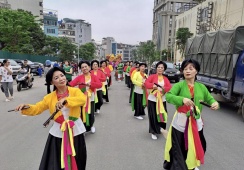
Hanoi is home to many Buddhist temples with fine architecture and long histories, such as Kim Lien, Mot Cot (One Pillar), and Tran Quoc Pagodas.
Kim Lien Pagoda in Tay Ho District was built in 1443 and venerates Buddha along with Princess Tu Hoa, who taught people how to raise silkworms and weave silk. The pagoda has a wealth of meticulous and detailed reliefs of dragons, clouds, and flowers.
Tran Quoc Pagoda (Tay Ho District) was the Buddhist center of Thang Long during the Ly-Tran Dynasty (1010-1400). Dating back up to 1,500 years, it is one of the oldest Buddhist sites in Vietnam.
| The One Pillar Pagoda has unique lotus-shaped architecture. Photo: VNA |
Chua Mot Cot, or One Pillar Pagoda, was built in 1049 after King Ly Thai Tong (1000-1054) dreamt that Avalokiteshvara had given him a shining lotus.
Pagodas are not only a concrete expression of Buddhist architecture but are also associated with national culture, a place to spread morality and reflect the customs and beliefs of the people.
Over time, the architecture of the pagodas is gradually changing, some have even been altered by different schools of architecture and no longer preserve their original Buddhist ideology and philosophy.
Risk of losing national identity
Buddhism was introduced to Vietnam over 2,000 years ago. As the faith spread, it gradually gave rise to physical structures such as pagodas, towers, monasteries, and others.
Over many historical periods, depending on the region and form of worship, the overall design or use of Buddhist architectural works has varied, incorporating elements of traditional architecture while maintaining unity within each sect and region.
| Some typical architecture of pagodas displayed at the National Museum of History in 2023. Photo: Ngo Minh/The Hanoi Times |
According to Venerable Thich Thien Nhon, Chairman of the Executive Council of the Vietnamese Buddhist Sangha, it has suffered from the effects of time, war, and urbanization. Many have been rebuilt and enlarged to accommodate the growing number of Buddhists and pilgrims visiting the pagodas, gradually eroding the original architecture. The new or restored buildings sometimes even contradict the Vietnamese Buddhist style of architecture. It's not uncommon to see a three-story flat-roofed house next to a moss-covered temple.
"Some places of worship have been built according to personal preferences, incorporating foreign cultural elements and creating alien structures that have nothing to do with national cultural identity," Nhon said.
Professor Nguyen Quoc Thong, the Vietnam Association of Architects, believes renovation is necessary. However, some inappropriate renovations run the risk of gradually undermining the traditional characteristics of Vietnamese pagodas.
"Some structures have not been carefully researched to fit the overall layout of the pagoda, negatively distorting it," Professor Thong said.
Digitizing Buddhist architecture
To help find solutions for preserving Buddhist architectural heritage, Venerable Thich Le Tri, Deputy Head of the Central Committee for Culture of the Vietnamese Buddhist Sangha, said it was urgent to draw up a set of standards for Buddhist cultural heritage.
| Pagodas are not only a concrete expression of Buddhist architecture but are also associated with national culture. Photo: Ngo Minh/The Hanoi Times |
Venerable Thich Le Tri recommends that building permits for Buddhist places of worship should have professional approval.
For conservation and restoration, Venerable Thich Le Tri said that old structures should be preserved, while additions must be in harmony with the architectural space.
Newly built pagodas must be adapted to traditional Vietnamese architecture, appropriate to each indigenous cultural area of the country.
Architect Dinh Viet Phuong believes it is necessary to accelerate the digitization of Vietnam's Buddhist architectural and artistic heritage.
"A monument is a combination of artifacts, landscapes, architecture, inscriptions, bibliographies, festivals, monument records, and legal documents related to the management, conservation, and promotion of historical values. Digitizing monuments, therefore, means digitizing this whole ecosystem. It's the database for renovating monuments, pagodas, and temples without distorting the original architecture," said architect Phuong.





